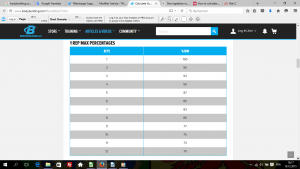After the post that I write about hypertrophy, I am interested in this famous 1RM, the heaviest weight that you can lift in 1 rep. because all two months I change my routine by adding weights or repetitions and it will make two months within days.
It was at that moment that I wondered if there is not a way to make a calculation instead of testing all weights in the gym. It’s especially saves time and energy because doing one session only to found 1RM, you’ll feel the session, you can’t even go home so you will be tired.
Firstly I came across an article on the website Bodybuilding.com with a table that calculates the weights for you, really convenient. Here is the link. And also a Wikipedia page where there are several formulas. There it was less funny, what formula to use now ?!? Wait, I give you the link. I was scared at the beginning for weight, I need to convert Kgs and Lbs but Wikipedia they say that it works for all, no need to convert.
And then I started to play with formulas, I create a file with Calc (Excel in LibreOffice) and I made a table with all my exercises and formulas. For formulas I use Lander’s formula, Bodybuilding.com use it too and Brzyci’s formulas, one of the most popular. Instinctively, I chose these two formulas, maybe later I’d also use Epley’s formula.
Direct Lander’s formula
1RM = (100 * weight) / (101.3 – 2.67123 * nbRep)
Direct Brzycki’s formula
1RM = weight * (36 / (37 – nbReps)
Then I did a calculation for the weight corresponding to 85% of 1RM. A little cross-multiplication, easy. Ah yes, I forgot on Bodybuilding.com, there is a table with the number of repetitions possible with the % weight relative to 1RM.
With this percentage, you can choose how or rather that how you’re going to work your muscles. In the old post I said do 6-8 reps allowed to gain strength and 12-15 reps allowed to gain volume but not strength. Did you see how it’s well detailed so I searched a bit and I found some advice.
50% of 1RM
Excellent to be explosive. You improve your pace and your speed to move like a boxer (12-20 reps).
70% of 1RM
Excellent for endurance. You want to make long distance, it trained your muscles to moving with moderate weight.
80% of 1RM
Excellent for muscles. You lift a difficult weight but allows you to do a nice reps numbers. You stress muscle fibers enough to force them to be thicker and bigger.
95% of 1RM
Excellent for power. You want to have a maximum strength quickly so you have raised truck and move fast.
These information are good to improve your training and don’t forget FEEL YOUR BODY during exercises, it’s useless to force out of pride to finish hurting and not being able to train for 6 months (you know yourself the side effects of an injury).
I do my new workout, I feel I could do more but as it’s the heaviest weight I lifted until now, I’ll stick with that. In any case all the reps were clean and I focus on technique. In two months I would increase 2 reps.
Well when I added my performance in my training diary, the volume of work decreased (increased weight and decreased reps). At first it made me shit because I wanted to go to a new workout based on the volume of work from the old workout. Well, after some calculation I quickly calmed me down when I saw the weight and reps number that I had to do to increase constantly my volume of work like this
It’s impossible, it’s necessary that there are ups and downs, that’s nature. There are still so many things that doctors always can’t explain about our body, you’d hallucinated, kind hockey, here, still nothing about it. It’s crazy, right!?!? But with such weight in 6 months, increasing by 2 reps every two months, I would be 10 reps and I will surpass my old volume of work. You see that, that makes me happy. Once I master 10 reps, I increase the weights and I go back down to 6 reps. I will stay with 85% of 1RM I think, I like it.
Test formulas and tests all this in your training, you will see it’s funny. But don’t forget, there is always a difference between theory and practice so LISTENING YOUR BODY.
-Steph
PS: Result difference I found between Lander’s formula and Brzycki’s formula is in average 0.2919339419. Yes, I know, I haven’t changed format cells so that gave me all decimals.





